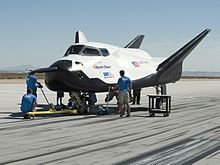 Sierra Space Dream Chaser at NASA’s Neil Armstrong Test Facility in 2024 | |
| Manufacturer | Sierra Space |
|---|---|
| Country of origin | United States |
| Operator | NASA |
| Applications | International Space Station (ISS) resupply |
| Specifications | |
| Spacecraft type | Robotic cargo vehicle version, also Crewed orbital spaceplane version |
| Payload capacity | 5,000 kg (11,000 lb) pressurized, 500 kg (1,100 lb) unpressurized |
| Crew capacity |
|
| Regime | LEO |
| Production | |
| Status | Active |
| Built | 3 |
| Launched | 0 (4 atmospheric tests) |
| Operational | 1 |
| Related spacecraft | |
| Derived from | HL-20 Personnel Launch System |
| Launch vehicle | Vulcan Centaur |

Dream Chaser is an American reusable lifting-body spaceplane developed by Sierra Space. Originally intended as a crewed vehicle, the Dream Chaser Space System is set to be produced after the Dream Chaser Cargo System cargo variant is operational. The crewed variant is planned to carry up to seven people and cargo to and from low Earth orbit.[1] Sierra plans to manufacture a fleet of the spaceplane.[2]
The Dream Chaser was originally started in 2004 as a project of SpaceDev, a company that was later acquired by the Sierra Nevada Corporation (SNC) in 2008.[3] In April 2021 the project was taken over by the Sierra Space Corporation (SSC), spun off from the Sierra Nevada Corporation as its own fully independent company.
The cargo Dream Chaser is designed to resupply the International Space Station with both pressurized and unpressurized cargo. It is intended to be launched vertically on the Vulcan Centaur rocket[4] and autonomously land horizontally on conventional runways.[5] A proposed version to be operated by European Space Agency (ESA) would launch on an Arianespace vehicle.
The Dream Chaser concept and design is a descendant of NASA's HL-20 Personnel Launch System.
- ^ Foust, Jeff (January 14, 2020). "Sierra Nevada explores other uses of Dream Chaser". spacenews.com. Retrieved July 11, 2020.
- ^ "Sierra Space Dream Chaser® Spaceplane Successfully Completes First Phase of Pre-Flight Testing". www.businesswire.com. March 7, 2024. Retrieved May 15, 2024.
- ^ Cite error: The named reference
AWST-19910715-26was invoked but never defined (see the help page). - ^ Cite error: The named reference
Vulcan-Selectionwas invoked but never defined (see the help page). - ^ Cite error: The named reference
subNASwas invoked but never defined (see the help page).